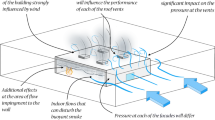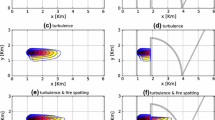Abstract
The control of forest fires is a very important problem for many countries around the world. Proper containment and risk management depend on the availability of reliable forecasts of the flame front propagation under the prevailing wind conditions, taking into account the terrain features and other environmental variables.
In this paper we discuss our initial development of the central part of an integrated system, namely a tool to simulate the advancement of the flame front. We discuss the pyrolisis model, the wood characteristics taken into account, and the modeling of heat exchange phenomena; this modeling tool is derived from the well known fluid dynamics code Kiva, originally developed for engine design applications.
Finally, we give an overview of the future directions of development for this activity, with special attention to the models of combustion employed.
Preview
Unable to display preview. Download preview PDF.
Similar content being viewed by others
References
Amsden, A.A.: KIVA 3: A KIVA Program with Block Structured Mesh for Complex Geometries, Los Alamos National Lab., Tech. Rep. LA-12503-MS (1993)
Patankar, S.V.: Numerical Heat Transfer and Fluid Flow. Hemisphere Publ. Corp. (1980)
Filippone, S., D’Ambra, P., Colajanni, M.: Using a Parallel Library of Sparse Linear Algebra in a Fluid Dynamics Applications Code on Linux Clusters. In: Joubert, G., Murli, A., Peters, F., Vanneschi, M. (eds.) Parallel Computing - Advances & Current Issues, pp. 441–448. Imperial College Press Pub. (2002)
Grosshandler, W.L.: RADCAL: A narrow-Band Model for Radiation Calculations in a Combustion Environment, NIST techical note 1402 (1993)
Shafizadeh, F.: The Chemistry of pyrolysis and combustion. In: Rowell, R.M. (ed.) The Chemistry of Solid Wood. Advances in Chemistry Series 207, pp. 489–530. American Chemical Society, Washington (1984)
Stamm, J.: Thermal degradation of wood and cellulose. In: Presented at the Symp. On Degratadion of Cellulose and CelluloseDerivatives, 127th National Meeting of theAmerican Chemical Society, Cincinnati Ohio (1955)
Shafizadeh, F.: Chemistry of Pyrolysis and Combustion of Wood. In: Proceedings of 1981 International Conference on Residential Solid Fuels - Environmental Impacts and Solutions, Cooper JA, Malek Deds, Oregon Graduate Center, Beverton, pp. 746–771
Hong, J.: Modelling of char oxidation as a function of pressure using an intrinsic Langmuir rate equation, Tech. Rep. Brigham Young University (2000)
Catchpole, W.R., Catchpole, E.A., Butler, B.W., Rothermel, R.C., Morris, G.A., Latham, D.J.: Rate of Spread of Free-Burning Fires in Woody Fuels in a Wind Tunnel USDA Forest Service, Rocky Mountain Research Station, Intermountain Fire Sciences Laboratory, Missoula
Author information
Authors and Affiliations
Editor information
Editors and Affiliations
Rights and permissions
Copyright information
© 2006 Springer-Verlag Berlin Heidelberg
About this paper
Cite this paper
Bella, G., Filippone, S., De Maio, A., Testa, M. (2006). A Simulation Model for Forest Fires. In: Dongarra, J., Madsen, K., Waśniewski, J. (eds) Applied Parallel Computing. State of the Art in Scientific Computing. PARA 2004. Lecture Notes in Computer Science, vol 3732. Springer, Berlin, Heidelberg. https://doi.org/10.1007/11558958_65
Download citation
DOI: https://doi.org/10.1007/11558958_65
Publisher Name: Springer, Berlin, Heidelberg
Print ISBN: 978-3-540-29067-4
Online ISBN: 978-3-540-33498-9
eBook Packages: Computer ScienceComputer Science (R0)




